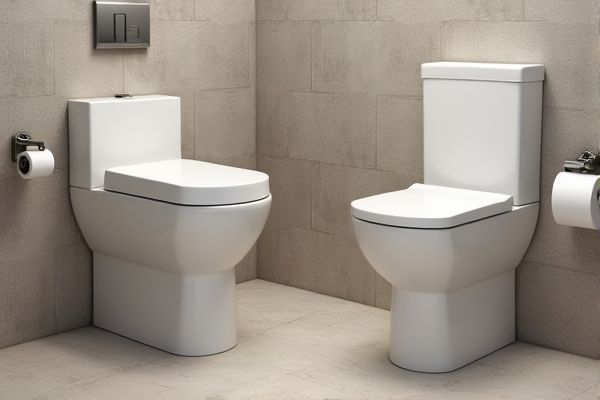
One-piece toilets feature a seamless design making them easier to clean and often more compact, while two-piece toilets, with separate tank and bowl components, typically offer more affordable options and easier repairs. Discover which toilet type best suits your bathroom needs by reading the rest of the article.
Table of Comparison
| Feature | One-Piece Toilet | Two-Piece Toilet |
|---|---|---|
| Design | Integrated tank and bowl, seamless | Separate tank and bowl, assembled |
| Installation | Easier, fewer parts | More complex, requires assembly |
| Cleaning | Smoother surface, easier to clean | More crevices, harder to clean |
| Durability | Less prone to leaks, sturdy build | Potential leak points between tank and bowl |
| Price | Usually higher due to design | Generally more affordable |
| Weight | Heavier, harder to move | Lighter, easier transport |
| Repair | More costly if damaged | Individual parts replaceable |
Introduction to One-Piece and Two-Piece Toilets
One-piece toilets feature a seamless design where the tank and bowl are integrated into a single unit, enhancing durability and ease of cleaning. Two-piece toilets consist of separate tank and bowl components, allowing for easier handling during installation and typically offering more model options. Each type varies in aesthetics, maintenance, and cost, with one-piece models generally being more streamlined and two-piece models providing greater flexibility.
Design Differences: One-Piece vs Two-Piece Toilets
One-piece toilets feature an integrated tank and bowl molded as a single unit, enhancing a sleek, seamless design that simplifies cleaning and reduces crevices where dirt can accumulate. Two-piece toilets consist of separate tank and bowl components joined during installation, offering easier repairs and replacements for individual parts but resulting in more visible seams and potential for leaks. The compact design of one-piece models suits modern bathrooms while two-piece toilets provide more traditional aesthetics with greater customization options.
Installation Process Comparison
One-piece toilets feature a streamlined design with the tank and bowl fused together, simplifying the installation process by reducing the number of parts and potential leak points. Two-piece toilets require assembling the tank and bowl separately, which can make installation slightly more complex and time-consuming due to the need to properly align and seal the components. Your choice affects ease of installation, with one-piece models generally offering quicker setup and less risk of assembly errors.
Cleaning and Maintenance Considerations
One-piece toilets offer seamless designs that reduce crevices, making cleaning faster and minimizing the buildup of dirt and bacteria. Two-piece toilets have a separate tank and bowl, which can create hard-to-reach joints where grime accumulates, requiring more frequent and detailed maintenance. Your choice impacts not only aesthetics but also how easily you can maintain hygiene in your bathroom.
Durability and Lifespan
One-piece toilets generally offer superior durability due to their seamless design, which reduces the risk of leaks and cracks commonly found in two-piece models where the tank and bowl join. Made from high-quality vitreous china, one-piece toilets can last up to 20 years with proper maintenance, outlasting many two-piece toilets that often face wear at the tank-to-bowl connection. The consolidated structure of one-piece toilets also simplifies cleaning and maintenance, contributing to their extended lifespan and reduced chances of mechanical failure.
Cost Analysis: Upfront and Long-Term
One-piece toilets generally have a higher upfront cost, ranging from $200 to $600, due to their integrated design and ease of installation, while two-piece toilets typically cost between $100 and $300. Long-term maintenance expenses are often lower for one-piece models because they lack the crevices where leaks and cracks commonly develop in two-piece units, reducing repair frequency and water waste. Energy and water efficiency ratings show minimal differences, but the durability and reduced maintenance of one-piece toilets can lead to overall cost savings over a decade.
Space and Aesthetic Impacts
One-piece toilets offer a sleek, compact design that saves space and creates a modern, seamless appearance ideal for smaller bathrooms or minimalist aesthetics. Two-piece toilets, with separate tank and bowl components, may occupy more space and can appear bulkier, but they provide easier access for maintenance and a classic look suited to traditional bathroom styles. Your choice can significantly influence the overall feel of the room, balancing space efficiency with the desired design impact.
Performance and Flushing Power
One-piece toilets typically offer superior performance and flushing power due to their integrated design, which reduces leaks and enhances water flow efficiency. Two-piece toilets may have more varied flushing performance depending on the model, as the separate tank and bowl can sometimes lead to minor leaks or weaker flushes. When choosing your toilet, prioritize one-piece models for reliable, consistent flush strength and easier maintenance.
Pros and Cons Summary
One-piece toilets offer a sleek design with easier cleaning due to the seamless construction, making them ideal for modern bathrooms, but they tend to be heavier and more expensive than two-piece models. Two-piece toilets are generally more affordable and easier to install or repair since the tank and bowl are separate, though they can be harder to clean because of the crevices between parts. Your choice depends on whether you prioritize aesthetics and streamlined maintenance or budget and flexibility.
Which Toilet Type is Right for You?
Choosing between a one-piece toilet and a two-piece toilet depends on factors such as bathroom size, ease of installation, and budget. One-piece toilets offer a sleek design and easier cleaning due to fewer crevices, making them ideal for smaller bathrooms or modern aesthetics. Two-piece toilets are generally more affordable and easier to repair since the tank and bowl are separate, making them suitable for larger bathrooms or budget-conscious renovations.
 homyna.com
homyna.com